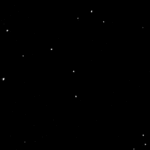12 Victoria
.png) Model of 12 Victoria made by light-curve inversion | |
| Discovery | |
|---|---|
| Discovered by | John Russell Hind |
| Discovery date | 13 September 1850 |
| Designations | |
| MPC designation | (12) Victoria |
Named after | Victoria (Latin: Uictōria) |
| none | |
| Main belt · Klio | |
| Orbital characteristics[1] | |
| Epoch 13 January 2016 (JD 2457400.5) | |
| Uncertainty parameter 0 | |
| Observation arc | 60430 days (165.45 yr) |
| Aphelion | 2.84931 AU (426.251 Gm) |
| Perihelion | 1.81758 AU (271.906 Gm) |
| 2.33344 AU (349.078 Gm) | |
| Eccentricity | 0.22108 |
| 3.56 yr (1302.0 d) | |
Average orbital speed | 19.50 km/s |
| 161.809° | |
| 0° 16m 35.429s / day | |
| Inclination | 8.36859° |
| 235.482° | |
| 69.5103° | |
| Earth MOID | 0.821096 AU (122.8342 Gm) |
| Jupiter MOID | 2.42194 AU (362.317 Gm) |
| TJupiter | 3.522 |
| Physical characteristics | |
| Dimensions |
112.8 ± 3.1 km (IRAS)[1] 124.09 ± 8.31 km[2] |
Mean radius | 56.385 ± 1.55 km |
| Mass | (2.45 ± 0.46) × 1018 kg[2] |
Mean density | 2.45 ± 0.67 g/cm3[2] |
Equatorial surface gravity | 0.0315 m/s² |
Equatorial escape velocity | 0.0596 km/s |
| 8.6599 h (0.36083 d)[1] | |
| 0.1765 ± 0.010[1] | |
| Temperature | ~178 K |
| S-type asteroid[1] | |
| 8.68[3] to 12.82 | |
| 7.24[1] | |
| 0.188" to 0.04" | |
|
| |
12 Victoria is a large main-belt asteroid.
It was discovered by J. R. Hind on September 13, 1850.
Victoria is officially named after the Roman goddess of victory, but the name also honours Queen Victoria. The goddess Victoria (Nike for the Greeks) was the daughter of Styx by the Titan Pallas. The coincidence with the name of the then-reigning queen caused quite a controversy at the time, and B. A. Gould, editor of the prestigious Astronomical Journal, adopted the alternate name Clio (now used by 84 Klio), proposed by the discoverer. However, W. C. Bond, of the Harvard College Observatory, then the highest authority on astronomy in America, held that the mythological condition was fulfilled and the name therefore acceptable, and his opinion eventually prevailed.[4]

Radar and speckle interferometry observations show that the shape of Victoria is elongated, and it is suspected to be a binary asteroid, with a moon of irregular shape.[5]
Victoria has only ever been observed to occult a star thrice since its discovery.
See also
References
- 1 2 3 4 5 6 "JPL Small-Body Database Browser: 12 Victoria" (2008-11-06 last obs). Retrieved 8 April 2016.
- 1 2 3 Carry, B. (December 2012). "Density of asteroids". Planetary and Space Science. 73: 98–118. arXiv:1203.4336. Bibcode:2012P&SS...73...98C. doi:10.1016/j.pss.2012.03.009. See Table 1.
- ↑ "AstDys (12) Victoria Ephemerides". Department of Mathematics, University of Pisa, Italy. Retrieved 2010-06-26.
- ↑ Schmadel, Lutz D. (2003). Dictionary of minor planet names. 1 (5th ed.). Berlin Heidelberg New York: Springer-Verlag. p. 16. ISBN 3-540-00238-3.
- ↑ Other reports of asteroid/TNO companions
External links
- "Elements and Ephemeris for (12) Victoria". Minor Planet Center. Archived from the original on 2016-03-04. (displays Elong from Sun and V mag for 2011)
- 12 Victoria at the JPL Small-Body Database
